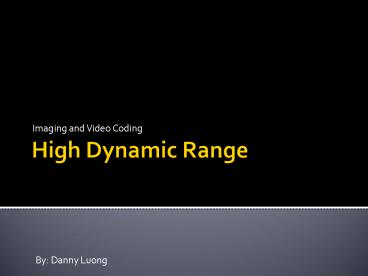High Dynamic Range - PowerPoint PPT Presentation
1 / 23
Title:
High Dynamic Range
Description:
There is a need to create frames with differing exposure values to generate ... XU, R., ET AL, 2005. High-Dynamic-Range Still-Image Encoding in JPEG 2000. ... – PowerPoint PPT presentation
Number of Views:190
Avg rating:3.0/5.0
Title: High Dynamic Range
1
High Dynamic Range
- Imaging and Video Coding
By Danny Luong
2
Topics Covered
- HDR Imaging Overview
- HDR Image Generation/Examples
- HDR Image Compression
- Tone Mapping
- HDR Video Overview
- HDR Video Generation
- HDR Video Compression
3
Motivation for High Dynamic Range
- A standard dynamic range image encodes luminance
values with 8 bits allowing only a range of
values from 0 to 255. - This range limits the ability of the image to
represent the true-to-life luminance and
intensity levels of a given scene. - The dynamic range ratio humans perceive is
approximately 100001, while standard cameras are
only capable of capturing 4001.
4
What is High Dynamic Range?
- High dynamic range imaging addresses this issue
of limited intensity ranges by using more bits to
represent luminance values (up to 32 bits). - HDR images can be generated using a set of low
dynamic range images, or using specialized
equipment. - There are issues with viewing HDR images on
standard display devices (tone mapping).
5
HDR Image Example
- LDR Image
- HDR Image
6
Pros, Cons, Applications
- Increased scene detail is preserved when
compared to LDR images. - Larger range of luminance values can be
represented. - Luminance values can be floating point, rather
than integer values. - - Larger file sizes
- Application More realistic motion blur
7
Motion blur of LDR/HDR images
- Original Photo
- Simulated blur-LDR
Simulated Blur-HDR
Real motion blur-HDR
8
Radiance Maps
- Radiance maps are used in generating a HDR image
from a set of LDR images. - Radiance maps have pixel values that are
proportional to the true radiance values in a
scene. - How? Given a set of LDR images with different
exposures, use an algorithm to combine the
luminance values. (There are a number of existing
algorithms)
9
Radiance Map
- HDR Image
- False Color Radiance map
10
HDR from LDR images
- Six LDR images taken with varying exposure values
- HDR image generated from six LDR images
11
Radiance Maps Generation
- Equation for irradiance of a pixel, i
- Radiance map using set of pictures
- Weighting function
- Camera response characteristic curve
- Method by Debevc Malik, 1997
12
HDR Image Compression
- The need for compression is apparent due to
increased file size of HDR content. - Different lossy and lossless compression schemes
for HDR images exist, including run length
coding, wavelet compression, subband encoding. - OpenEXR (near-lossless wavelet) has 21
compression ratio, while lossy JPEG2000 at rate
0.05 is indistinguishable from original.
13
HDR Image Compression II
- Standard JPEG2000 block diagram
- HDR JPEG2000 compression extension
14
HDR Image Compression III
- Map HDR pixel values to log domain and convert
floating point values to integers - where
- Use JPEG2000 encoder with RGB to YCbCr space.
- Use wavelet transform and quantize with stepsize
15
Tone Mapping
- Tone mapping is a method of representing a space
of values with a large range into a space with
limited range. - Tone mapping is needed because current display
devices cannot physically reproduce luminance
values apparent in the real world. - There are many different methods of tone mapping
(local, non-local). - Tone map for display on LCD, projector, etc.
16
HDR Video
- Like HDR imaging, there are different possible
ways to obtain HDR video. - Methods include HDR capable capture video cameras
(costly), fixed mask, adaptive light modulator,
and varying exposures for alternate frames. - Like HDR imaging, display to standard monitors
requires tone mapping, but normalization across
frames must be applied.
17
HDR Video Example
- Top original frame sequence
- Bottom HDR frame sequence
18
Generating HDR Video
- The method we will cover is alternating frame
exposures, also called HDR stitching. - There is a need to create frames with differing
exposure values to generate radiance maps at each
instant. - A warping process is used to generate
interpolated frames. - Any method of radiance map generation can be used
on the pairs of frames.
19
HDR Stitching
Next (Short Exposure) Frame
Prev (Short Exposure) Frame
Generated Frame
Generated Frame
Generated Frame
Generated Frame
Current (Long Exposure) Frame
20
HDR Stitching II
HDR Frame
Generated Frame
Generated Frame
Radiance Map
Generated Frame
Generated Frame
Current (Long Exposure) Frame
21
HDR Video Coding
- HDR video can be compressed using MJPEG2000,
where each individual frame can be compressed
using the HDR JPEG2000 compression method covered
earlier. - Other methods exist for compression, one based on
MPEG4 is by Mantiuk, et al. (2004)
22
HDR Video Coding II
- Steps in coding (Mantiuk, et al., 2004)
- Convert HDR XYZ color space to Lpuv
- Quantization of luminance values
- Motion estimation
- Perform DCT
- EITHER quantize OR
- Use hybrid method
- Hybrid method reduces
- edge artifacts (run length
- encoding of hi-freq content)
23
References
- http//www.mpi-inf.mpg.de/resources/hdr/
- http//en.wikipedia.org/wiki/High_dynamic_range_im
aging - http//en.wikipedia.org/wiki/Tone_mapping
- http//www.debevec.org/Research/HDR/
- http//www.cybergrain.com/tech/hdr/
- http//www.naturescapes.net/072006/rh0706_1.htm
- DEBEVEC, P. E., AND MALIK, J. 1997. Recovering
high dynamic range radiance maps from
photographs. In Proc. ACM SIGGRAPH 97, T.
Whitted, Ed., 369378. - KANG, S.B., ET AL. 2003. High Dynamic Range
Video. In In ACM Trans. Graph., vol. 22, no.
3,2003, pp. 319-325. - MANTIUK, R., ET AL. 2004. Perception-Motivated
High-Dynamic-Range Video Encoding. In ACM Trans.
Graph., vol. 23, no. 3,2004, pp. 733-741. - XU, R., ET AL, 2005. High-Dynamic-Range
Still-Image Encoding in JPEG 2000. In IEEE
Computer Graphics and Applications., vol. 25, no.
6, 2005, pp.57-64.































